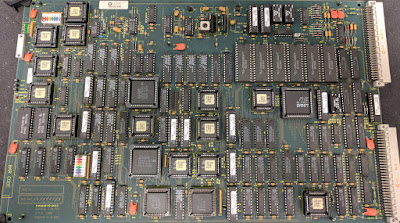The Quantel HAL is an evolution of the V-Series architecture that Quantel introduced in the late 1980s as used originally on the 2nd generation Paintbox, it expands on it with upto 18 plugin expansion cards on it's expanded backplane (Hiway as Quantel call it) housed in a 6U chassis.
The Quantel HAL system is a video compositing system that can composite upto 99 'layers' in a single pass. Layers would be static images, video clips or stencils (masks) that can all be manipulated in a 3d space along with various effects that can be applied. Video storage is on a separate 'Dylan' disk array connected via a proprietary interface and contains 24gb of disk storage to give a total of 15 minutes of uncompressed standard def PAL/NTSC video.
In many ways it's similar to the Quantel Harriet, which is a combination of a Paintbox and Ramcorder. The Harriet is designed for compositing static pictures and animation on top of video and is limited to 323 frames in the Ramcorder. The HAL differs in it has far greater storage and can composite video on video with key (stencil) channels on any of the 99 layers.
The user places video clips, pictures and stencils onto a keyframe timeline to create a sequence of effects which are then rendered out to a new clip or composited over the top of an existing clip.
The main chassis contains two hard disks, a system boot disk and a shared disk. The boot disk contains all the software and local files, the shared disk contains all the network shared files. This setup is exactly the same as the Paintbox. There are 4 SDI video inputs and outputs, 1 (stereo) digital audio input and 2 outputs along with an analog 'broadcast standard' video in/out.
The PSU and two hard disks are mounted in the top.
The Dylan disk array contains 20 fujitsu 1.2gb 3.5" SCSI disks each with it's own SCSI controller a lot of logic and a small Inmos/ST transputer CPU to look after the array. There is no CPU code stored on the array as it's loaded over a dedicated 'inmos link' when the main system boots. The array CPU simply looks after errors from the disks. From what i understand the HAL writes video round-robin to the disks. There is ECC so the data on a failed drive can be rebuilt once it's replaced. The array also stores the disk serial numbers of the drives in an EEPROM to prevent user-replacement of the disks. If a disk is changed the system will flag the disk and stop using it. Once two disks are either flagged as serial number changed or have found to be faulty the array will go offline and the user is unable to have access to video on the HAL. The capacity of the array is determined by the software keys on the HAL system, so probably all disk arrays had 24gb but depending on how much ££ you paid quantel you could have access to 5, 10 or 15 minutes of video.

Top view of the Dylan 2 disk array. The Inmos CPU is in the top left corner, PSU in the middle and the SCSI controllers around the edge with the cables running to the disks.
HAL System cards:
The HAL contains the usual 3 cards found in any v-series system. CPU, Mainstore, Diskstore and some kind of image processing card like is found in a Paintbox. So this could be Size, Rotation, Perspective, CAP (Contour and Perspective) or Image. With Image being the most advanced.
CPU: Quantel's standard CPU42 board with 64mb RAM & 68040 CPU.
Netcomm: Quantel's standard netcom board, 68000 based network interface.
Input Select: Analog video input processing card and digital video input (the actual digital input decoding is processed on a smaller board located in the top of the chassis).
APE: Audio processing card.
Image: Essentially a software CPU / processing engine based on a large quantity of altera CPLDs and an Inmos/ST Transputer CPU, provides all the processing for image transforms (size, rotation, 3d effects etc).
Diskstore: Regular diskstore card.
Mainstore: Regular mainstore card.
Output Select: Analog video output processing & digital video output (the actual digital output decoding is processed on a smaller board located in the top of the chassis).
Mux: interface to the dylan disk array.
Disk Link: I think more disk array interface stuff.
Router: I think this does some switching of video to/from the disk array.
Key 2: lots of logical processing on this card, going by it's name it must be something with video keying.
Vid Proc 2: like Key 2 this has lots of 'bit-twiddling' ICs for image processing.













